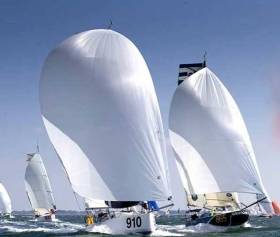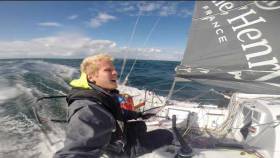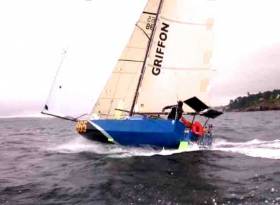Displaying items by tag: Mini Transat
Student Mark O'Connor Qualifies for the Mini Transat Race
Dun Laoghaire sailor Mark O'Connor has solo transatlantic ambitions and here, the 23-year-old UCD engineering student details his journey to 2023 Mini Transat qualification
To qualify for a Mini Transat, one must complete 1500 miles of Classe Mini Regattas and complete a 1000-mile solo qualification loop.
The Atlantic route takes you from France, around the Scillies to avoid the Penzance TSS, to Conningbeg, to the Rochebonne Plateau (near to La Rochelle) around Ile de ré (La Rochelle) and then back to where you started. I am pleased to say that I have now completed both of these! I departed for my Qualification on the 6th of August 2022, and it took me 8 days and 18 hours to complete the 1000nm (1852km) course. Below is a brief summary of the trip. I have now collated my necessary documents and submitted them to the class in Lorient for Ratification.
I have since delivered the boat to Concarneau for my next and final regatta of the season, the Dou Concarneau. As the name would suggest, it is a double-handed race, consisting of 330 miles starting and finishing in Concarneau. It is in Concarneau that I am planning to spend the winter as I have found a place in the Mini “Pole au Large” Training Centre. I am really pleased with this, as it is such an amazing opportunity to improve my sailing from some of the best coaches in the game.
I left Douarnez on the Friday with a fresh NE breeze, which gave me a nice fetch through the “Chenal du four”. A leaking petrol can was a slight nuisance as it was making the cockpit smell, but I was careful to ensure that it stayed in the cockpit and that no petrol made it to the inside of the boat. After a day or so, when the waves calmed down, I was able to decant the remained of the jerry can into the outboard.
 Leaving the bay to start my Qualifier. Courtesy Flag flying in front of the Cap de la Chevre Coast Guard Station
Leaving the bay to start my Qualifier. Courtesy Flag flying in front of the Cap de la Chevre Coast Guard Station
The first crossing of the English Channel was very pleasant, with 16 knots for a one-sided beat. A wind shift mid-way through allowed me to make the Scillies without a further tack. Having my phone on board was a bit of a novelty, as I wouldn’t normally have it for Mini Races. Getting forecasts and updates from Home was nice, but it was also a bit of a distraction at times.
After the Scilly Isles, the wind dropped off, which meant it was slow going on a beat up towards Waterford. About 20 miles from Conningbeg, the wind filled in with about 12 knots, which meant I rounded in the early hours of the morning. Then it was a 120 mile Run back down to the Scillies, unfortunately, the wind shut off the day after turning back south, meaning I was in for my second drift day of the qualifying loop. However, I had heeded the advice given to me by fellow ‘ministes’, and brought a few books to read when there was no breeze. (This particular day, I finished Richard Osman’s The Man Who Died Twice’, which I would highly recommend). These calm days were also a great opportunity to get sight readings using the sextant and to take recordings of the Forecasts revied via the LW radio. Both of which are mandatory requirements for the qualification.
 Rounding Conningbeg cardinal mark during the night
Rounding Conningbeg cardinal mark during the night
For my second crossing of the English channel, I had a lovely stable 15 knots just over the back quarter for the first 3/4s of the crossing. Just after entering the channel, I managed to wrap the kite during a launch just after sunrise which made a small tear. Nothing unrepairable, but this meant I was back to the Medium Spi for a couple of hours while I dried it and patched it up. This nice 15 knots of breeze picked up to 30 knots of breeze as I came around the outside of the Ushant TSS. This was great fun surfing down the waves at 8 or 9 knots. This lasted well into the night. Just after midnight while I was surfing with the code 5 spinnaker up, I had a flyby by the ocean 50, Gitana at 26 knots!
All the surfing made for great progress towards the Rochebonne plateau, which I rounded on day 6. It was a tight fetch into La Rochelle to round Ile de Ré, which gradually turned into a run later in the day. It was again light winds by the time I had reached Ile de Re and set up for my approach to the bridge. Unfortunately, the tide was against me in this narrow straight. Therefore I crossed it, and tacked in close to the shore and the commercial port in order to hide from it. I spent the next few hours under the cover of darkness tacking alongside the cargo ships and sneaking closer to the bridge. As I was getting ready to pass beneath it, the wind increased, and the tidal stream was easing so I managed to pass through with little interference. I even overtook another Mini during my short tacking efforts! Not that it was a race, but the satisfaction of knowing my efforts were rewarded was a great moral boost. After passing clear of the fish traps, it was time for a well-deserved sleep, while travelling under the code 0. I made good northerly progress for the rest of the night and the next morning all while catching up on some valuable sleep. It was later after I had passed the Glenans around noon, I encountered my third and final ‘drift day’. This one was the most frustrating by far, As I only had around 50 or so miles until my finish, but with 1/3 knots of wind, I wasn’t going anywhere in a hurry. I spent the day doing some small splicing jobs around the boat and a general tidy up. Arriving at the La Rochelle/Ile de Ré Bridge with 27 degrees at 9 o'clock in the evening
Arriving at the La Rochelle/Ile de Ré Bridge with 27 degrees at 9 o'clock in the evening
Around seven o’clock that evening, the wind filled in. With the wind, however, came the lightning squalls. I went from 3 knots to 20 in the space of fifteen minutes, needed to reef the main in between. As a precaution, I unplugged the VHF antenna from the masthead. The lightning storms kept rolling in all night with winds reaching 25 gusting 30. It was under these conditions that I had to cross the notorious Raz de Sien in, with the current against me. When the lightning started to fork a couple of miles from the boat, I decided it would be a good idea to isolate the batteries and electronics, ie, I’d be flying without my instruments or autopilot.
Thankfully by the early hours of the morning, the storms were mainly in the distance, so I was able to turn back on the pilot and get some quick naps. Around 6am I could once again see the Green light at the end of the pier wall of Douarnenez, meaning my 1000-mile qualification loop was at a close.
My Take home lessons from the qualification loop were, 1) Always triple-check things, especially when you are tired. It's worth taking the extra 30 seconds to catch a problem rather than wrapping a kite etc. 2) Preparation for the smallest things is key. One of the nicest luxuries was putting on a fresh and dry set of socks! Before I left, I vacuum bagged some of my clothes in preparation for the cabin being soaked with water. This paid dividends after a week at sea. Prepping my food by making it easily accessible and divided into day bags meant it was easy to be disciplined with rations, and I would always have something to hand 3) Don’t stress about things you can’t control; the wind will come or it won’t.
Mini Transat Leader 200 Miles From Finish, While Port of Galway Is 17th
Pierre Le Roy sailing the uber-scow Teamwork has a good lead in the Euorochef Minitransat 2021 as he closes towards the finish at Saint-Francois in Guadeloupe 200 miles away, where he is expected to cross the line tomorrow (Friday) evening.
With nearly a hundred miles in hand on the next boat, Fabio Muzzolinini’s Tartine, he has been benefitting from being first to the fresher winds on the western side of the Atlantic, circumstances which had dictated that the fleet trended well south in search of better pressure in mid-ocean.
Ireland’s Yannick Lemonnier, sailing the veteran 2004 Sam Manuard design Port of Galway, was at one stage showing a class best placing of tenth in the Proto division, but today (Thursday) he was recorded in 17th place, with 750 miles still to sail to the finish.
Race tracker here
Galway Solo sailor Yannick Lemonnier Finishes First Stage Mini-Transat In 16th Place
Solo sailor Yannick Lemonnier racing Port of Galway finished the first stage of the Eurochef MiniTransat 2021 at 16th in class this afternoon (Saturday) at Palme in the western Canaries, having moved up a couple of places during the final approach to the port of Santa Cruz de la Palme.
While many of the fleet are still at sea, the top performers who managed to avoid the storm-enforced stop in northwest Spain last weekend have now carved out a wellnigh unassailable lead.
But with 85 boats still racing, there is plenty of competition at mid-fleet to provide the French-born Galway-based sailmaker with some excellent boat-for-boat competition in the main Transatlantic leg.
Details here
Two-part Mini Transat Fleet Closing in on Volcanic Palma
The Minis Transat fleet was emphatically divided by hundreds of miles when the leaders managed to get themselves well south past Cape Finisterre in northwest Spain before ferocious weather and aggressive killer whales forced a significant section of the fleet - including Ireland’s Yannick Lemonnier racing Port of Galway - to seek shelter in ports in the Vigo region at the weekend. Nevertheless when they got going again only three boats of the fleet of 90 didn’t resume racing, the most spectacular exit from the lineup being by Black Mamba, which had found an immovable bit of Spain blocking her route while trying to make port.
The four leading boats - all from the Proto class - were in a race of their own, and the first stage to Santa Cruz de la Palma (yes, that Santa Cruz de Palma, volcanoes and all) was won by Tanguy Bouroullec on his Pogo, going so well that he was into port on Monday barely a day after the tail-enders had got away from Galicia. The first Serie boat, SignForCom raced by Melwin Fink of Germany, made a masterful job of the downwind sailing to finish well ahead of any classmates at 13.30 French time today (Thursday).
Yannick Lemonnier has been getting every last ounce of speed out of his 2004 vintage-but-modified Port of Galway, and is lying 17th as he approaches the latitude of Madeira making 7.6 knots, but with higher speeds expected in an improving wind pattern.
Tracker here
While the leading boats in the fleet of 90 racing the Mini Transat 2021 are now passing Madeira and well on their way to their planned stopover in the Canaries (where they may well find that volcanic activity interferes with arrangements), some craft in the main part of the fleet suffered so much from extreme weather and whale attacks off northwest Spain that they were forced to seek shelter and safety in the nearest harbours.
Among them is Yannick Lemonnier in his boat Port of Galway, who got to Baiona near Vigo after a section of the fleet pulled in there to avoid heavy weather and orca attacks. The Minis were being thrown around like dinghies by the orcas, and apparently the substantial aluminium Mini 650 Transat Support Boat was attacked by whales - they had a determined go at his rudder.
Several other boats have been towed to Baiona, while a UK vessel was towed to Vigo and a Swiss boat to Cangas. The activity of the whales is very high off Galicia right now, and the current advice is not to transit these waters until later in October.
As for the situation with the volcanic eruptions on their destination of La Palma, that is “being monitored”.
Race tracker here
Galway's Yannick Lemonnier Aims for Mini Transat 2021 in September
Quite a few of us still think of Yannick Lemonnier as the keen young French guy who came to Galway by way of Dingle, and in time became the Irish branch of Quantum Sails, with a new loft in the City of the Tribes. But he turned 50 last July, and was thinking of unfinished business, even though he and his son Sean – they're a formidable team – were on their way to winning the Cong-Galway Race for the second year running.
Being King Cong twice on the trot would be enough for most of us for a while. But Yannick was remembering that, when he got into top-level competitive sailing on his native waters in the Bay of Biscay at the age of 26, his foremost ambition was to race the Mini Transat 6.5 across the Atlantic
 King Cong. Sean Lemonnier and his dad Yannick after winning the Cong-Galway race for the second year running
King Cong. Sean Lemonnier and his dad Yannick after winning the Cong-Galway race for the second year running
You might well think that as the boats are only 6.5 metres in overall length, there'd be more of them available second-hand for rookie skippers. But on the contrary, around La Rochelle he found that Figaro boats of several vintages were in much more plentiful and affordable supply for charter, and he found himself being "trapped" into competing in no less than five Figaros.
And when he started to make his mark on the Irish scene, it was racing the Figaro 2 DoDingle in the 2004 Round Ireland Race in the Two-Handed Division, co-skippering with Galway's Aodhan FitzGerald to such good effect that their time stood as the Two-Handed Round Ireland Record until 2016, and even then it was only bested by a Belgian Class 40 which in turn was beaten by Pam Lee of Greystones and Cat Hunt in a Figaro 3 in October 2020.
 The newly-acquired boat making well to windward, but nevertheless reminding us that when all is said and done, a Mini 6.50 is just 21.3 ft long. Photo: Afloat.ie/David O'Brien
The newly-acquired boat making well to windward, but nevertheless reminding us that when all is said and done, a Mini 6.50 is just 21.3 ft long. Photo: Afloat.ie/David O'Brien
But by 2016, while Yannick had made a significant mark on Irish sailing, the Mini-Transat itch hadn't gone away, and by 2018 he'd bought a well-proven Sam Manuard-designed Mini 491 with which he promptly won the developing Mini class in that year's Round Ireland Race, and the following year, after regular shipmate Dan Mill the ace boatbuilder had sustained a serious knee injury 24 hours before the race, he won the class in the Dun Laoghaire-Dingle Race 2019.
He was ultimately crewed with minutes to spare by pierhead jumper John Malone of Lough Ree YC, Ireland's SB20 Class President, who subsequently provided an entertaining account of what it's like to be power-hosed for hours on end while your Mini 6.50 tears down Ireland's East Coast with everything set in a roaring nor'easter at an average of 22 knots.
 An already well-worn Lough Ree YC cap has taken another battering – SB20 Class President John Malone and Yannick Lemonnier at the conclusion of a successful Dun Laoghaire to Dingle Race 2019. Photo: John Malone
An already well-worn Lough Ree YC cap has taken another battering – SB20 Class President John Malone and Yannick Lemonnier at the conclusion of a successful Dun Laoghaire to Dingle Race 2019. Photo: John Malone
The basic design of Mini 6.50s has moved on since this boat first appeared, as we well know from the appearance of current "Irish Sailor of the Year" Tom Dolan's Pogo 3 Smurfit Kappa, which placed sixth in 2017's hop across the pond. But Yannick Lemonnier's boat still has plenty of oomph, so much so that designer Sam Manuard has come on board with plans for a new twin daggerboard arrangement which he reckons will bring on planing speeds earlier, thanks to a slight inward angle, thereby providing the possibility of sustaining 24 knots for long periods.
 View from astern, showing new starboard foil activated. Sam Manuard has angled the new asymmetrical foils slightly inwards, on the theory that they will start to provide real lift sooner than a vertical or outward-angled foil
View from astern, showing new starboard foil activated. Sam Manuard has angled the new asymmetrical foils slightly inwards, on the theory that they will start to provide real lift sooner than a vertical or outward-angled foil
 As the foil in use will be on the opposite side to the canting keel, both will be operating in relatively undisturbed water
As the foil in use will be on the opposite side to the canting keel, both will be operating in relatively undisturbed water
These very special asymmetrical carbon foils are being made in a purpose-created workshop unit in a corner of the Quantum Galway premises by Dan Mill in an upgrade and campaign project currently being supported by Port of Galway, Quantum Sails, Premium Ropes, Dubarry, the Irish Mini Class and West Sails.
Once the boat is afloat, the programme is hectic:
- Early April : launch then testing of new Dagger boards and new mast rake between Galway Bay and Dingle
- End April: 1000 miles solo non-stop qualifier course finishing in La Trinite Sur Mer
- 22th May start of the "Mini en Mai 6.5", La Trinite Sur Mer, 500 miles/ solo
- 13th June start of the "Mini Fastnet 6.5" , Douarnenez, 600 miles/ double handed
- 28th July start of the "Mini Gascogna", 580 miles/ double-handed (Backup race in case there was an issue finishing a previous race)
- 26th Sept, the start of the Mini Transat 2021:
- Leg 1: Les Sables D'olonne- Santa Cruz de la Palma (Canary Island), 1350 miles
- Leg 2: Start early November Santa Cruz de la Palma (Canary Island)- St Francois (Guadeloupe), 2700 miles
- Early December loading boats for shipping back to France
 Course for the Mini Transat 2021, starting on September 26th at Les Sables d'Olonnne. By the time Yannick Lemonnier is on the starting line, he will already have sailed thousands of miles with his re-configured boat
Course for the Mini Transat 2021, starting on September 26th at Les Sables d'Olonnne. By the time Yannick Lemonnier is on the starting line, he will already have sailed thousands of miles with his re-configured boat
Despite the intensity of the programmme, Yannick reckons the longest he'll be away from the loft is one period of only 16-17 days, but in any case, Quantum colleagues in Ireland such as Mark Mansfield, and others abroad, will be rallying round to maintain the well-established smooth service.
As we emerge from lockdown, it will be fascinating to follow this very special example of competitive sailing life returning to our seas, and grasping the first possible opportunity to fulfill a long-held dream. For as Yannick himself says: "You only live once".
Ocean Yacht Racing Goes Mainstream. Is Irish Sailing Ready? And Willing?
With three major yet very different marathon sailing events crossing the Atlantic this month, it’s clear that the once decidedly quirky and often eccentric devotees of offshore and ocean racing are becoming mainstream. This is further reinforced by the confirmation – which has been flagged for a long time now – that World Sailing and the Olympics organisation will be evaluating an experimental two-handed and possibly gender-mixed offshore contest in parallel with the sailing events at the Tokyo 2020 Olympiad. W M Nixon wonders if long-serving offshore racing enthusiasts will really be a hundred per cent in support of these developments.
In sailing as in politics, ultimately everything is local. We’d always been interested in the Mini-Transat, but never more than the time when Enda O’Coineen did it rather longer ago than he cares to remember. And when the second stage of this year’s race got going from Las Palmas to Martinique on November 1st, the hearts of the Irish sailing community were with our folk hero Tom Dolan, the farmboy from Meath who has shown he can cut it with the best of them in this uniquely demanding branch of the ocean game.
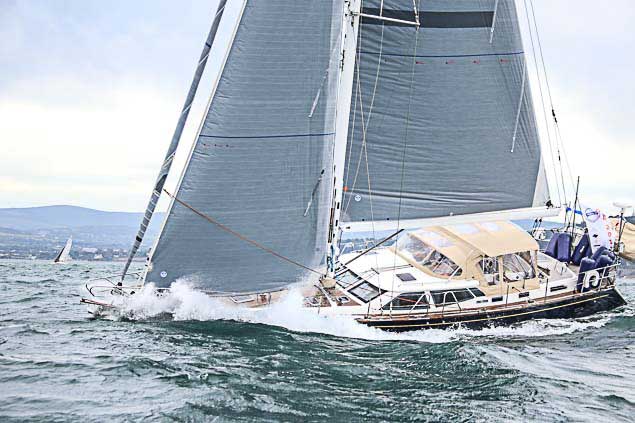 Never mind the weather, the tent is up and setting a treat…..Unlike the Mini-Transat boats which crossed the Atantic two weeks in advance of them, the crew of former Round Ireland winner Eamon Crosbie’s Discovery 55 Pamela will be enjoying considerable comfort during the ARC 2018. Photo David O’Brien/Afloat.ie
Never mind the weather, the tent is up and setting a treat…..Unlike the Mini-Transat boats which crossed the Atantic two weeks in advance of them, the crew of former Round Ireland winner Eamon Crosbie’s Discovery 55 Pamela will be enjoying considerable comfort during the ARC 2018. Photo David O’Brien/Afloat.ie
Then when the huge ARC 2017 got its incredibly varied fleet lumbering away last weekend, again from Gran Canaria, this time towards St Lucia, we tried to take an overview of the fleet, but inevitably became focused on Eamon Crosbie’s Discovery 55 Pamela from Dun Laoghaire with a merry crew on board. We’ve been observing that, like the rest of the fleet, she has found anything but regular northeast tradewinds out in the Atlantic, but she’s getting there nevertheless – race tracker here
This weekend, there’s some quite heavy metal – some of it distinctly luxurious in tone – getting started in the RORC’s Transatlantic Race from Lanzarote, with the finish in Grenada. The fleet of 23 make up in quality what it lacks in quantity, for though the smallest boat is the JPK 10.10 Jangada, the largest is Daniel Stump’s Southernwind 96 Sorceress, while the longest is Ludde Ingvall’s uber-skinny 98ft Maxi CQS from Australia.
It’s aboard this extraordinary yoke that Ireland’s Sailor of the Year 2013 David Kenefick, now 26, is sailing as skipper. In an acknowledgement to the sheer power and reach of the French sailing scene, the young Cork sailor had been declared “Rookie of the Year” in the Figaro Solo circuit in 2013, and to the surprise of some of the more traditionally-minded adjudicators, this was seen by the sailing public as more important than some major achievements within Ireland, so four years ago Kenefick became their Number 1.
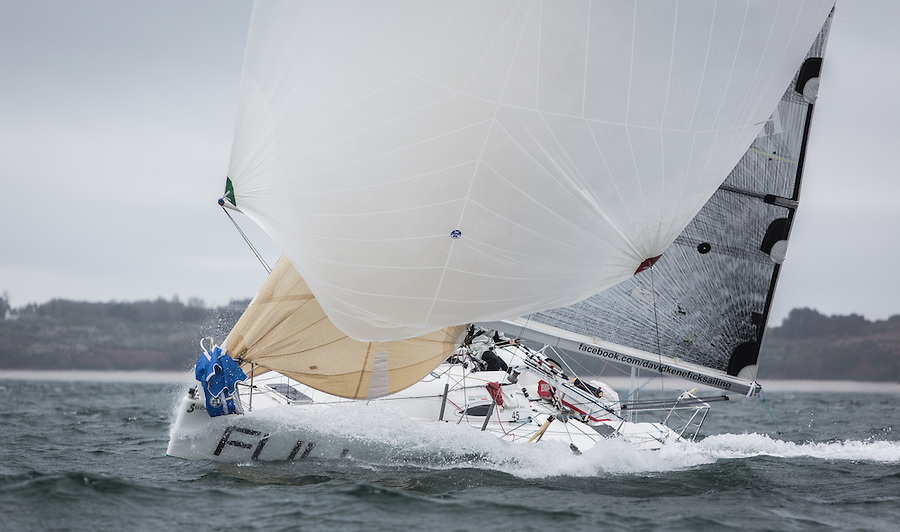 Somewhere in there on his Figaro Solo is David Kenefick, Ireland’s “Sailor of the year” 2013. Photo: Brian Carlin
Somewhere in there on his Figaro Solo is David Kenefick, Ireland’s “Sailor of the year” 2013. Photo: Brian Carlin
"Ludde is a legend and it is a great privilege to sail with him as skipper of CQS,” commented Kenefick. We have a young and multinational crew and we cannot wait to take on the challenge. CQS is a fantastic race boat and I am sure we are all going to learn so much after 3,000 miles.”
“In my early days I had the pleasure of racing with Harold Cudmore and we are still great friends,” said Ludde Ingvall. “I remember meeting with Harold and asking him what drives us on, now that we have been racing so many years. He replied we must 'pass it on' and that is what we are doing for young sailors that show great ability and the attitude to succeed.”
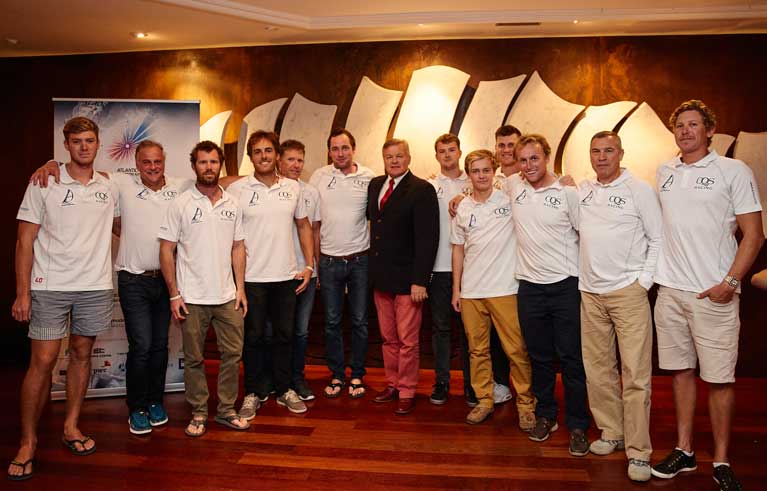 CQS crew – 26 year old Dave Kenefick pictured (centre) with Ludde Ingvall at tne gala dinner and his Australian 98ft Maxi CQS in the RORC Transatlantic Race starting from Lanzarote. Also pictured (fourth from left) is Royal Ulster Olympian James Espey
CQS crew – 26 year old Dave Kenefick pictured (centre) with Ludde Ingvall at tne gala dinner and his Australian 98ft Maxi CQS in the RORC Transatlantic Race starting from Lanzarote. Also pictured (fourth from left) is Royal Ulster Olympian James Espey
It will be intriguing to learn from one of our own just what it’s like to sail on something like CQS, which you can see as either counter-intuitive, or else so very intuitive that she has come out the other side. And with Kenefick on board, we will be keeping a special eye on her showing as the longest boat.
In between CQS and the “little” Jangada, there’s an eclectic selection including that old war horse, the Volvo 70 Monster Project (Roman Guerra). But generally they’re top end boats of comfortable size while being competitive at the same time. And with a considerable emphasis on European entries (there are boats from nine countries), they’re living proof that the story of the Eurozone’s economic recovery is true, and it’s out there and floating on the Atlantic.
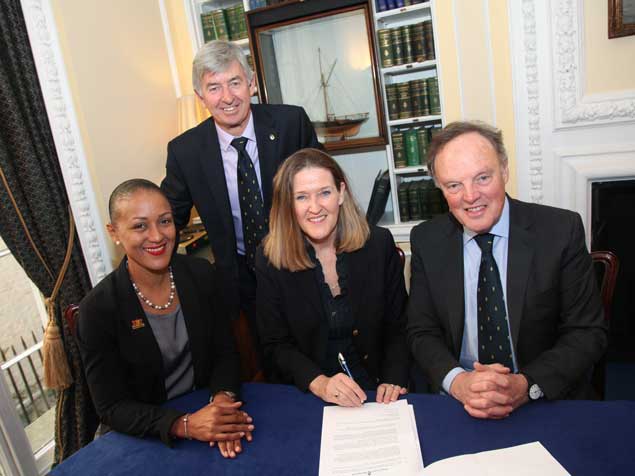 At the signing of the agreement to stage the RORC Transatlantic race from Lanzarote to Grenada are (left to right) Francine Stewart (Marketing Manager, Grenada Tourism Authority), Eddie Warden-Owen (CEO, RORC), Patricia Maher (Grenada Tourism Authority) and Michael Boyd (Commodore, RORC)
At the signing of the agreement to stage the RORC Transatlantic race from Lanzarote to Grenada are (left to right) Francine Stewart (Marketing Manager, Grenada Tourism Authority), Eddie Warden-Owen (CEO, RORC), Patricia Maher (Grenada Tourism Authority) and Michael Boyd (Commodore, RORC)
Typical of this is hyper-keen French owner-skipper Eric de Turkheim from La Rochelle, who we also feel is one of us, for if it hadn’t been for Rambler 88’s almost freakish performance in last year’s Volvo Round Ireland Race, his unusual-looking but effective Teasing Machine II would have been the overall winner.
Since then he has come up with the new 54ft Teasing Machine III, and though she wasn’t ready in time for the Fastnet Race in August, she made an impressive debut in the Middle Sea Race in late October, and would have been second overall if another of those pesky JPK 10.80s, this time the Russian-owned Bogatyr, hadn’t come out of the woodwork at the end, and snatched the win by six minutes, while Teasing Machine II was relegated to a close third overall.
So between CQS and Teasing Machine, we have favourites to follow. And although the RORC fleet start all of a week after the ARC, the winds along the sunshine route to the Caribbean are in such a wayward mood that it’s going to be fascinating comparing the relative performance of the two groups.
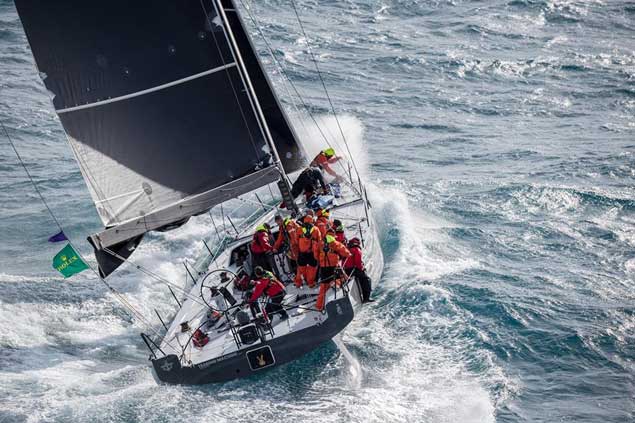 The new 54ft Teasing Machine II on her way to third overall in her first major event, the Rolex Middle Sea Race 2017. Photo Rolex
The new 54ft Teasing Machine II on her way to third overall in her first major event, the Rolex Middle Sea Race 2017. Photo Rolex
But what on earth, you might well wonder, is all this recitation of Atlantic voyagers and racers to do with giving only two instead of three cheers for the prospect of World Sailing shoe-horning offshore racing into the Olympics?
It’s simple. Offshore racing and its many organisations and events are so varied that trying to channel them into the narrow perspective of the Olympics, with its over-long four year cycle, is going to result in a very artificial construct. And the idea of having a man-and-woman crew of two who are declared to be the World Champions and Olympic Gold Medallists is so remote from the delicious, invigorating and multi-interest variety of the current offshore and ocean scene that we could be talking about two different planets.
For sure, it’s a notion which will appeal to newspaper headline writers. In the real red-top trade, sailing only makes sense when it’s in the Olympics or somebody is drowned. Beyond that, it’s simply too complex, varied and – let’s face it – self-absorbed, to promote itself as some sort of arena sport.
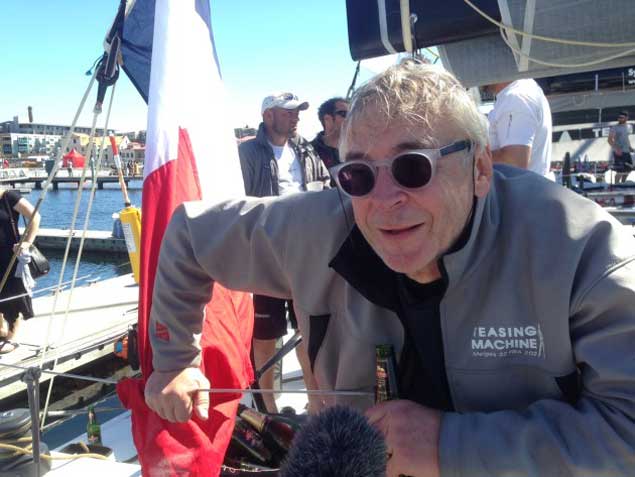 Eric de Turkheim, popular owner of Teasing Machine III, in Sydney preparing to race Teasing Machine II with success in the Sydney-Hobart Race
Eric de Turkheim, popular owner of Teasing Machine III, in Sydney preparing to race Teasing Machine II with success in the Sydney-Hobart Race
It was quite some time ago when two top honchos in American sailing announced that they were determined to reduce the number of world titles recognized by the then International Yacht Racing Union, which went on to become ISAF, and is now World Sailing. Back in the day, these guys reckoned that the 143 different IYRU-recognised classes with International status being each entitled to their own World Championship was a nonsense, and numbers should be reduced.
You can see why they thought so. One hundred and forty three sailing world champions might seem a bit over the top. But the idea went down like a lead balloon. People cherish their own classes, they cherish their own world titles, and they cherish their own local setup. And though they take a polite interest in World Sailing’s new look World Championship for Olympic classes, as it so often seems to be held on the other side of the world they’ll only engage if they happen to know of someone taking part.
So it’s complicated enough with inshore racing. But when you add in the extra factors involved in the much more complex and quirky world of offshore and ocean racing, it sometimes goes beyond understanding.
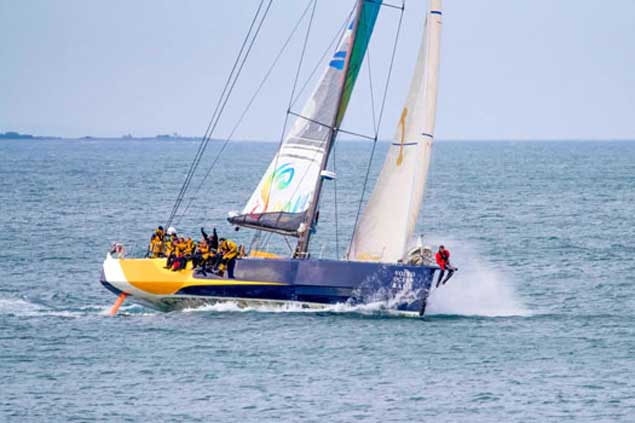 The old war horse. The Volvo 70 Monster Project coming to the finish to take line honours in the 2014 Round Ireland Race. She’s still going strong, and is one of the entries in the RORC Transatlantic Race. Photo WSC
The old war horse. The Volvo 70 Monster Project coming to the finish to take line honours in the 2014 Round Ireland Race. She’s still going strong, and is one of the entries in the RORC Transatlantic Race. Photo WSC
Yet the way things are provides something for everyone in the audience. While we pay lip service to approving the moves towards synchronising the IRC and ORC measurement systems, there’s a little bit of us that thinks it’s actually a pretty good idea having the two, as it allows for even more prizes, and they keep up the interest across a broader spectrum of the fleet.
Equally, an almost mind-numbing variety of events and organisations, a whole world away from the rigid one design format proposed for the Olympics offshore racing tryout, is what the global scene in the offshore game is all about. Think, for instance, of the 240 people from both sides of St George’s Channel who gathered at the Irish Sea Offshore Racing Association’s annual black tie dinner and prize-giving earlier this month in the National Yacht Club. All power to the great Peter Ryan for organising it, these were genuine sportsmen and women who are dedicated to their interest afloat, yet somehow trying to link them directly to the sterile world of the Olympics just doesn’t make sense.
At the other extreme, our own deservedly admired 2016 Olympic Silver Medallist Annalise Murphy instantly made herself much more interesting, much more of a three-dimensional character, when she courageously took on the crewing job aboard Turn the Tide on Plastic in the Volvo Ocean Race. There’s no doubt that having the fitness of an Olympic athlete is a real asset in a Volvo 65, but the concept of the Volvo Ocean Race is a million miles from Olympic theory.
In a different direction, sailing also includes the craziness of the America’s Cup, but in the offshore and ocean sphere, it’s generally agreed that the supreme event is the Vendee Globe. Nothing could be simpler in concept than one sailor on his or her own racing non-stop round the world out of a French port which finds it has stumbled on a world-beating event. Yet nothing is more complex than the actual machinations of the Vendee Globe, but the Olympic ideal it ain’t.
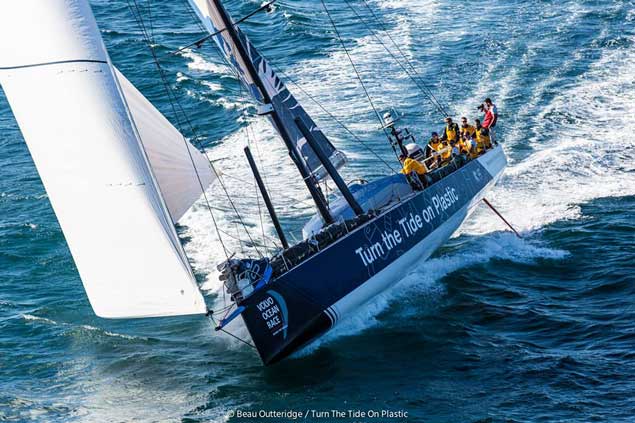 A very different machine from a Laser Radial – Silver Medallist Annalise Murphy is one of the round the world crew on turn the Tide on Plastic
A very different machine from a Laser Radial – Silver Medallist Annalise Murphy is one of the round the world crew on turn the Tide on Plastic
But despite these enormous difference, the fact of offshore racing becoming linked to the Olympics might make life a little easier for people like Tom Dolan who have literally re-invented themselves in the strange world of solo offshore racing, but find it extremely difficult to explain to non-sailors, especially those who might have a sponsorship budget, just what’s going on. However, mention the Olympics, and it’s a bit of a light-bulb moment.
That said, the proposed Olympic offshore course will be light years away from what Tom Dolan and his comrade-rivals put themselves through during the first 15 and more days of November. We carried an extract of winner Erwan Le Daroulec’s take on it earlier this week, but it’s worth repeating (and don’t sign off, the real meat of this week’s blog is at the end). Le Draoulac wrote:
“I brought a book with me, but I never thought to read it. I helmed, I ate, I slept, I answered the calls of nature, a real animal life. It was a nightmare.
The boat was soaked the whole time. I never dumped any sails, I just went up forward to reinforce my bowsprit. To get to sleep when I was under autopilot, I put on my headphones with some audio books and I listened again to the whole of Harry Potter. It was the only way of preventing stress whilst the boat was powering along at 18 knots, sometimes under autopilot, but I never eased off the pace.
It was only in the last two days where I dropped the large spinnaker in the squalls. I said to myself that it would be too silly to break everything so close to the goal. Prior to that though I really attacked hard. I knew I was risking a dismasting, but my line of thinking was that I was only twenty years old and that I’d have the opportunity to do another Mini-Transat. I didn’t make the most of it, I didn’t enjoy it. I’d like to the cross the Atlantic again, but gently so as to make the most of it.”
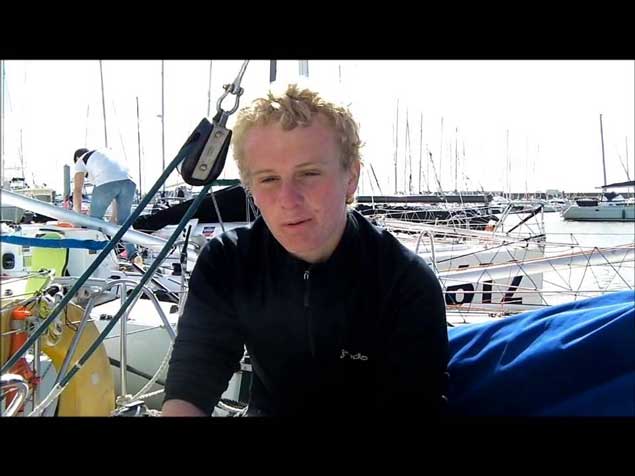 Erwan le Draoulec – he won, and won well, but says he didn’t enjoy it at all
Erwan le Draoulec – he won, and won well, but says he didn’t enjoy it at all
We really must try a dose of the old Harry Potters the next time insomnia comes along…..but seriously, what sort of a sailing world have we created, that a 20-year-old old is trained to such a level of performance that he can turn in an incredibly brave and skilled world-beating performance, yet actually hates every minute of it?
That said, Tom Dolan reckons he only feels truly alive when he’s “in the zone”, racing his little boat flat out. However, since he finished he has quietly revealed that, two days out from the finish, he survived an experience which was beyond fulfilling.
He was running in the dark in about 30 knots of wind and going a dream under the small spinnaker, nicely on track for fourth with a good chance of a bite at third, when out of the still-total blackness a 45 knot squall struck. IRL 910 went faster and faster, then a steep one lifted her from astern, and the tip of her stemhead went under the bow-wave. Within seconds, she’d done a complete pitchpole.
Tom found himself in the water in the dark, and his boat inverted for what seemed forever beside him. But she shook herself upright, he hauled himself aboard, and to his amazement everything, rig and all, still seemed intact. It was the first time he’d ever heard of a Min-Transat boat pitch-poling and not being dismasted, and miraculously it had happened to an under-funded Irishman who was campaigning on little more than wing and a prayer. He still had his wing. He will have sent have up a little prayer of thanks.
Then it was right back full on into the race, and we’ve all seen the vid of him finishing. But it’s worth repeating. You’re looking at a real hero.
He was within 48 minutes of being third and on the podium, but it was miraculous he was there at all. As for the final overall placings based on the total accumulated times for the two legs, the word is that won’t be officially announced until the Paris Boat Show on December 8th, when they’ll also stage the prize-giving.
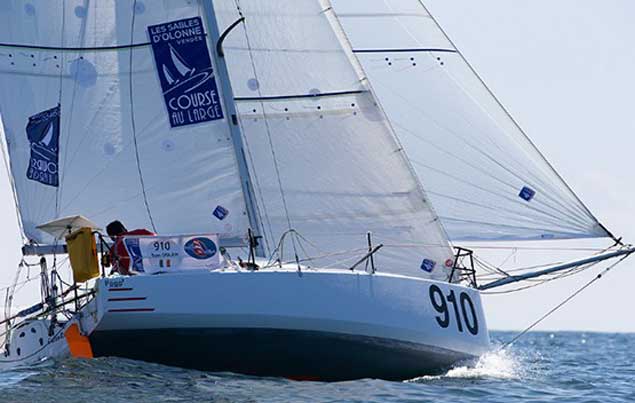 Tom Dolan with his new boat in 2016, when he won his first race. It has been revealed that he came fifth in the second leg of the Mini Transat despite being pitch-poled two days before the finish
Tom Dolan with his new boat in 2016, when he won his first race. It has been revealed that he came fifth in the second leg of the Mini Transat despite being pitch-poled two days before the finish
At the Paris Boat Show they’ll also officially announce the Golden Globe 18, golden oldies of a past era racing round the world in celebration of the Golden Jubilee the original Golden Globe, the non-stop round the world solo race of 1968 which was won by Robin Knox-Johnston in Suhaili. To be eligible, you have to be racing a “closed profile” (ie non fin-and-keg) boat of around 36ft, and Ireland’s Gregor McGuckin is entered with a Biscay 36 which he is currently preparing.
But as the organisers couldn’t get any British port associated with the original race to take it on fifty years later, Les Sables d’Olonne in France, home of the Vendee Globe, stepped up to the plate, and they will be the host port. It’s a perfect illustration of the huge spread of French interest in offshore racing. In fact, you might be making a sensible wager if you bet on France to support the new offshore event in the Olympics, but only if they can present the medals at the subsequent Paris Boat Show…
Meanwhile, as to Ireland being ready and willing for involvement in an Olympic offshore racing class, we certainly have plenty of keen young ocean racers, both men and women, who will be mustard keen if the resources can be found to get their campaigns under way. But as it is, the world of offshore racing is already rich in its diversity without being forced into any Olympic straitjacket. And that’s the way it is in Ireland too. We seem to like it that way too, but if the Olympics come calling, they’ll be welcome to join the party.
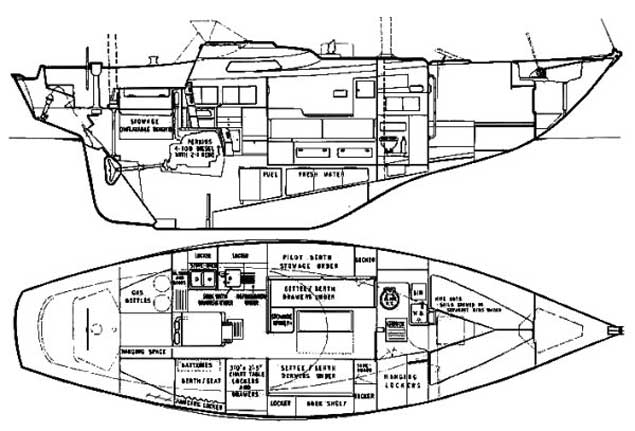 Tough and compact – the hull profile of a vintage Biscay 36. Ireland’s Gregor McGuckin will be racing one in next year’s Golden Jubilee of the Golden Globe Race. But despite the original having started and finished in England, the 2018 version will start and finish in France
Tough and compact – the hull profile of a vintage Biscay 36. Ireland’s Gregor McGuckin will be racing one in next year’s Golden Jubilee of the Golden Globe Race. But despite the original having started and finished in England, the 2018 version will start and finish in France
Mini-Transat La Boulangere 2017: Official Final Total Times Expected Soon
Even as the huge fleet of cruisers and racers - including Eamon Crosbie’s Discovery 56 Pamela from Dun Laoghaire - are into the third day of their Transatlantic crossing in the ARC 2017 from Gran Canaria to St Lucia, on the other side of the ocean at St Marin in Martinique, the number-crunchers for the Mini-Transat La Boulangere 2017 are putting the last touches to their official statement of the overall final results writes W M Nixon.
These will emerge from the amalgamation of the official times of Legs 1 – from La Rochelle in France to Las Palmas in the Canaries, and Leg 2 – from Las Palmas via a gate in the Cape Verde Islands to Martinique. This may sound simple enough, but the tail enders were still tumbling in to St Marin right through the weekend, and with so much at stake with some quite substantial sponsorships involved among the 80 or so finishers, they have to be sure that no infringement of regulations is revealed after they have published results.
However, as an interim move this morning, they published the provisional results for Leg 2, and Ireland’s Tom Dolan is confirmed as fifth, just 48 minutes after third-placed Benoit Sineau. The brief official statement is as follows:
Mini Transat
Erwan Le Draoulec (Emile Henry) crossed the finish line in the second stage of the Mini Transat La Boulangère on Thursday, November 16th at 2h50'15 '' (French time). His race time on this 2nd stage is 14 days, 12 hours, 42 minutes, 15 seconds at an average speed of 8.43 knots.
There has been a flood of finishers over the past few days, and these are the top ten finishers in the Proto and Series fleets for the second leg from Las Palma to Le Marin:
PROTO:
1. Ian Lipinski
2. Jorg Riechers
3. Simon Koster
4. Andrea Fornaro
5. Keni Piperol
6. Quentin Vlamynck
7. Camille Taque
8. Aurelien Poisson
9. Arthur Leopold Leger
10. Frederic Guerin
SERIES:
1. Erwan Le Draoulec
2. Clarisse Cremer
3. Benoit Sineau
4. Tanquy Bouroullec
5. Thomas Dolan
6. Pierre Chedeville
7. Valentin Gautier
8. Germain Kerleveo
9. Yannick Le Clech
10. Cedric Faron
Meanwhile, here are thoughts on his race from Production Boat Winner Erwan le Draoulec which give us some idea of what is involved:
“I brought a book with me, but I never thought to read it. I helmed, I ate, I slept, I answered the calls of nature, a real animal life. It was a nightmare.
The boat was soaked the whole time. I never dumped any sails, I just went up forward to reinforce my bowsprit. To get to sleep when I was under autopilot, I put on my headphones with some audio books and I listened again to the whole of Harry Potter. It was the only way of preventing stress whilst the boat was powering along at 18 knots, sometimes under autopilot, but I never eased off the pace.
It was only in the last two days where I dropped the large spinnaker in the squalls. I said to myself that it would be too silly to break everything so close to the goal. Prior to that though I really attacked hard. I knew I was risking a dismasting, but my line of thinking was that I was only twenty years old and that I’d have the opportunity to do another Mini-Transat. I didn’t make the most of it, I didn’t enjoy it. I’d like to the cross the Atlantic again, but gently so as to make the most of it.”
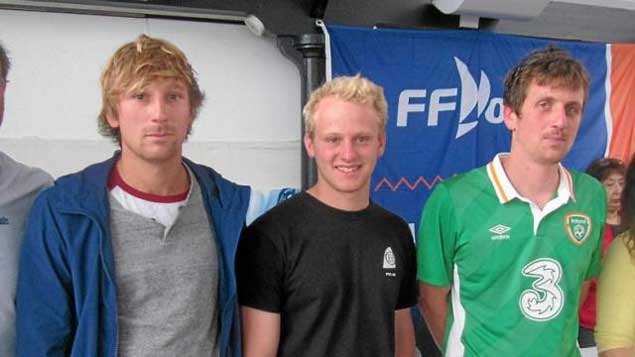 Comrades and rivals – Pierre Chedeville, Erwan Le Draoulec and Tom Dolan
Comrades and rivals – Pierre Chedeville, Erwan Le Draoulec and Tom Dolan
Tom Dolan Still Has Slim Thread of Hope for Mini-Transat Podium
With Production Class winner Erwan Le Draoulec finished early this morning in the Mini-Transat 2017 with a very clear lead, Irish solo sailor Tom Dolan’s many supporters at home and abroad maintain a slim hope that he might yet scrape through to a podium finish writes W M Nixon.
He has had a good night’s racing in fifth place, and has closed up to just two miles astern of Tanguy Boroullec in fourth and five miles behind Benoit Sineau in third, while Sineau still has 37.2 to race to the finish at Le Marin on Martinique.
However, Clarisse Cremer lying second well ahead has only 17 miles to go and is making 9.3 knots in a steady breeze, as is Sineau. But the two boats astern of him – Bouroullec and Dolan - are slightly slower at 8.9 for Bouroullec and 8.7 for Dolan.
Doubtless these speeds will pick up as they begin to enjoy the fresher breeze ahead. Yet with such even matching of speeds, the chances of position changes at this late stage are receding. But we live in hope. And with 25 miles clear back to sixth-placed Pierre Chedeville, Tom Dolan is at least reasonably sure of a fifth.
Tracker here
Mini-Transat: Tom Dolan Will Have All to Play for in Final Two Hundred Miles
Fortunes have waxed and waned as the 80 little boats in the Mini Transat Boulangere close towards the finish of the 2,000 mile transoceanic leg from Las Palmas in the Canaries - via a mandatory gate in the Cape Verde Islands - to St Marin in Martinique in the Caribbean writes W M Nixon.
Bowling along in the fluctuating east to northeast tradewinds, as expected the Prototype Division’s Ian Lipinski with the scow-bowed Griffon.fr has led the fleet overall to the line. He finished yesterday, and Proto runner-up Jorg Riechers is only slowly approaching the line in locally very light airs for his finish this morning.
It’s a result which gives Lipinski a remarkable double, as he won the Production Class in the previous staging of this biennial classic two years ago – it’s the first time in the 40 year history of the event that the double has been achieved.
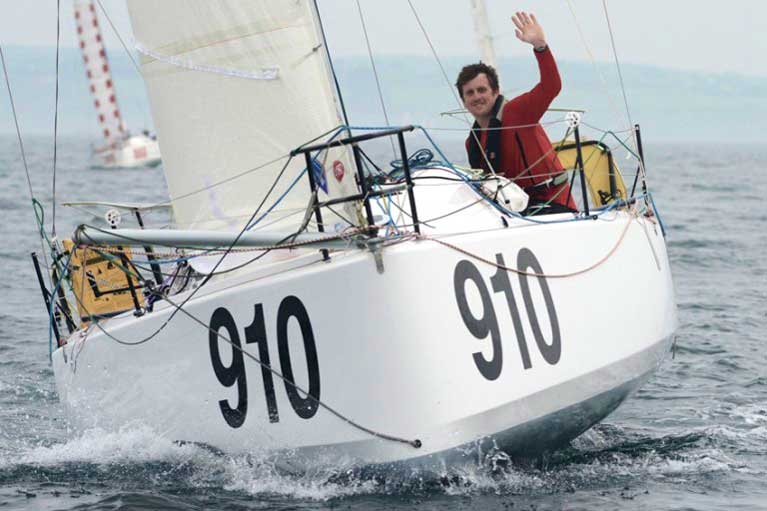 Tom Dolan, Ireland’s second-ever entrant in the Mini-Transat (Enda O Coineen was the first a long time ago), is facing a battle for fourth or perhaps third place in the Production Class in the final 200 miles of the Mini-Transat
Tom Dolan, Ireland’s second-ever entrant in the Mini-Transat (Enda O Coineen was the first a long time ago), is facing a battle for fourth or perhaps third place in the Production Class in the final 200 miles of the Mini-Transat
In this year’s Production Class, Ireland’s Tom Dolan has found himself entering the concluding two hundred miles in a four-way battle for the final position in the quartet which will fill the second, third, fourth and fifth places. However, “four way battle” is only a relative term imposed by the considerable distance being raced. This morning, twenty miles separate Clarisse Cremer in second from Dolan in fifth, as they have respectively 89.7 and 109.7 miles to the leader Erwan le Draoulec, who is in turn 145 miles from the finish.
Dolan has a good chance of improving to fourth as he is only 4 miles astern of Benoit Sineau currently in fourth, and the Irish sailor has marginally improved his position during the past four hours. But options for making major tactical gains are closing off as the finish is neared and the fleet’s tracks get closer together.
At the front of the Production fleet where the leaders are racing the Pogo 3, wunderkind Erwan Le Draoulec – he’s aged just 20 – is in a world of his own with those 145 miles still to sail. With nearly 90 miles clear of second-placed Cremer, his current speed of 7.7 knots is currently maintaining his lead. That said, as Jorg Riechers has been learning the hard way in recent hours, actually getting to the finish line off a Caribbean Island can sometimes be difficult for the final few miles. But nevertheless Le Draoulec has every reason for confidence.
Tracker here




























